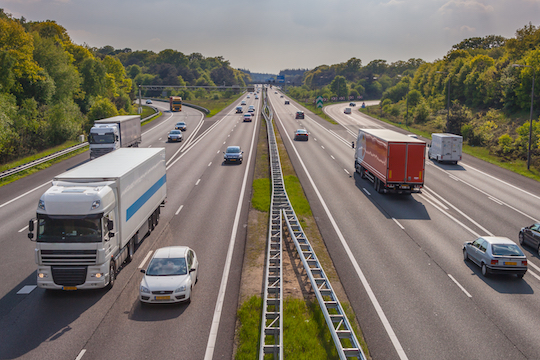Fuel efficiency and GHG emissions from rough roads on a per vehicle basis are minor. But with the 3.21 trillion miles all vehicles travel each year, it adds up.
The speed and efficiency with which vehicles travel on the asphalt highways are not unlike the Olympic swimmer plying his or her way through water. In both cases, the moving objects want to get to their destination with utmost energy efficiency.
The parallels between Michael Phelps and a semi trailer hauling sofas and jacuzzis end with that, for the most part. But just as fiercely competitive swim coaches have devised polyurethane low-drag swimsuits as a means to develop a nice, smooth glide from one end of the pool to the other, highway engineering researchers – many with an eye on fuel efficiency and greenhouse gases (GHGs) – work to make smooth pavement maximally efficient as well.
This is good not only for commuters, but for the asphalt and concrete construction contractors who perform the upkeep on our nation’s infrastructure.
Those highway researchers, such those at the National Center for Asphalt Technology (NCAT) at Auburn University (Alabama) and their counterparts at the Concrete Sustainability Hub at the Massachusetts Institute of Technology (asphalt and concrete industries are somewhat competitive in the pavement world), have identified several factors that measure how road quality affects fuel efficiency.
Now to be clear, other factors affecting fuel efficiency – engine type and other mechanical factors, tire construction, cab aerodynamics, etc. – have a far great impact on individual vehicles. Think of how Michael Phelps is naturally built and intensively trained as compared to, oh, actor Danny DeVito. But in macro, given that the vehicle miles traveled in America were 3.21 trillion miles in 2018, it’s a bit easier to see how this affects total fuel consumption and the environmental effects. Overall traffic and travel are much more efficient if those roads are smooth and, certainly, pothole free.
Actually, potholes and ruts are very obvious evidence of rough roads. But on a microscale, there are smaller but impactful differences as well. Measurement of these differences go beyond subjective driver experiences in that the American Society for Testing and Materials has devised what’s known as the response-type road roughness measurement system, or RTRRMS. Sensors attached to a vehicle gather data to grade road quality for various purposes, and have been used on streets, expressways and highways all across the country.
The ways in which smooth pavement is defined relative to fuel efficiency include several categories of measurement:
Pavement tire rolling resistance: This is the basic measure of energy loss due to tire contact with pavement (if only we drove hover vehicles, right?). At the most, it can affect fuel efficiency by about 1 percent.
Pavement stiffness (viscoelasticity): While a factor, this is considered a very minor influence on energy use efficiency.
Pavement texture/smoothness: This is the factor with greatest impact. A study by the Federal Highway Administration (FHWA) in 2000 found that trucks running on slightly smoother pavement could cut fuel consumption by 4.5 percent. An additional benefit of smoother pavement is vehicle operating cost reductions, due to less bounce. Also, driver fatigue was reduced with a smoother ride, potentially adding a safety benefit.
In macro, rough roads cost motorists $23 billion per year, per research by The Road Information Program (TRIP). There even is some data that suggest smooth roads themselves last longer than rougher pavement.
The swimsuits worn in the 2008 Beijing Olympics were banned from international competition because they provided too much of a technical advantage to swimmers. Fortunately, no one is stopping development of smoother, longer-lived pavement materials and construction methods. Better is better where it comes to smooth pavement.






